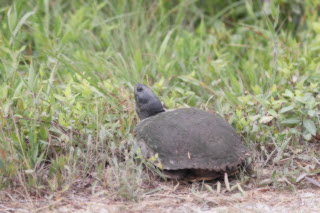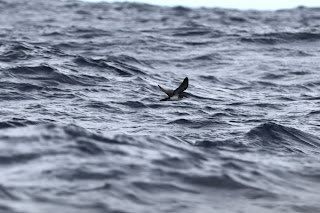Obviously, a big reason I went to North Carolina was to see birds. The whole trip was built around my two pelagics. Obviously that didn't work out so well since I was so sick on one, that I didn't go on the other eating $180. However, I did get some great birds on the trip. I had three lifers. I got one of them on the boat trip. I already wrote about the Black Necked Stilts at Bombay Hook, so I won't talk about them for more than a couple of sentences here. If nothing else, scroll to the bottom to see the amazing Barred Owls, they were awesome.
I got my first lifer on our drive down to Virginia stopping in Connecticut. It was Monk Parakeet. I tried for them on my way down to Washington DC in March but dipped. Since they were only two miles off of the highway in Bridgeport we stopped again. We saw four or five Monk Parakeets (yes, these are naturally wild birds). After we watched them for a while, we ate supper at the picnic tables near the ocean while listening to them squawk.
My second lifer was on the pelagic trip to the Gulf Stream. We came across a Brown Booby. One was actually in Rhode Island for a couple months last year. You needed to charter a boat to see it, but timing was never right for me. The Brown Booby on the pelagic was seen early in the morning. I had already gotten sick, but managed to get vertical for five minutes to see it. I got one good photo as it flew by the boat and three blurry ones.

My last lifer was on our last day in North Carolina. Phil Rusch had researched places to go birding. They found out a Red Cockaded Woodpecker was near Alligator River. When I found out about this, we altered our plans a little. We got up extremely early to go chase this bird before making the four hour drive to Assateague Island. Phil's friend David gave me the GPS coordinates, and Scott gave me landmarks to tell me exactly what trees to look for. It took almost thirty minutes for the woodpecker to show up, but it was awesome and walked up multiple trees with us watching.
Other "Good" Birds
A "good bird" is really in the eye of the beholder. While most people wouldn't chase a cardinal around here, it would be a big deal to see one in Oregon. So I went down there hoping to see some species that would be a big deal up here, but are more common down there. For example, if a Prothonotary Warblers shows up in Rhode Island everyone goes to see it. Usually one to three will come thru each year. However, in swamps in North Carolina, they are as common as Robins on our front lawn. There are hundreds along the roads at Alligator River. So what may not be a good bird to others, may be a good or even great bird for me. Which is why "My" is in quotes in the title of this post.
Prothonotary Warbler
Bobwhite
Sandwich Tern
Blue Grosbeak
Eurasian Collared Dove
I was really surprised to find this bird on Okracoke Island. We were walking through\
a suburban neighborhood on our way to a conservation area when I spotted it.
Fun facts about me seeing a King Rail (the two photos below). I had never seen or heard one until this year. I got my lifer one in March while looking for Sika Deer at Blackwater NWR in Maryland. I only heard it, didn't see it. Then in May, my buddy Sue Palmer found one at Trustom Pond in RI. I got to see it and had a great look at it. It counted as a state bird. Then in NC, Phil Rusch got four of them calling in a little marsh near my campground. I got to hear all of them even though we didn't see any. Then! I found my own where we saw all of the Cottonmouths. So after going my life without seeing or hearing one. I get a lifer, then two months later I see one and it is a RI state bird. Then I hear four more, then I find one myself. Just a crazy statistic.

A rarer bird around here, Brown Thrashers were very common in the mid-Atlantic states.
If I took the time, I'm sure I could have gotten "perfect" photos
Common Galinule
Not a good photo, but a photo upgrade of an Audubon's Shearwater
Below are photos of three common species. The White Ibis is common in the south. So common, that even for me, I've seen a lot. The Orchard Oriole and Eastern Kingbird are common in New England, but they are photo upgrades so I'm including them.
 |
Orchard Oriole,
Bombay Hook NWR |
 |
Eastern Kingbird,
Bombay Hook NWR |
Other than lifers, Black Necked Stilt was the species I most wanted to see on my trip. I really wanted a good picture. I don't think I got close enough for any great photos, but I'm happy with what I got.
Lastly, we ran across some Barred Owls that were hanging around the road. There must have been a nest with juveniles close because they were feeding during the day. We drove up and down the road multiple times looking for bears. We didn't stay with the owls for more than a couple of minutes. None the less, they were awesome. I'm sure I could have watched many fascinating behaviors if we stayed with them. The seemed unfazed by people watching them. But being around any nesting birds is not my style, especially owls. So I am more than thrilled to have gotten the photos I got. None of the photos have been enhanced in any way.






















































